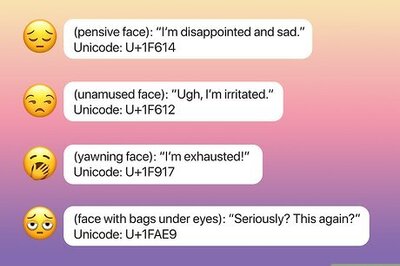
views
Popular instant messaging app WhatsApp has been under scrutiny ever since the Pegasus spyware attack, for failing to protect its users’ privacy. Israeli firm NSO’s spyware, called Pegasus, exploited vulnerabilities in WhatsApp’s end to end encryption and put thousands of users at risk, including targeted attacks on the phones of politicians, journalists, and human rights activists, including in India. Although the popular Facebook-owned messaging app proclaims the efficiency of its end-to-end encryption, it did not stop its users' data and privacy to be breached. Although one could shift to more secure instant messaging apps like Signal or Telegram, nothing beats the popularity that WhatsApp enjoys as a platform in terms of sheer user-base. So, if you can’t avoid using Whatsapp, here are six ways you could try making conversations and the app a bit more private.
Turn On Screen Lock/ Fingerprint or Face ID For WhatsApp
WhatsApp has an in-built screen lock, which users can access through the app’s privacy settings. Open WhatsApp on your phone and go to Settings > Account > Privacy> select “Screen Lock" > and enable it. Your app will now require you to enter your screen lock before it launches. In fact, WhatsApp now provides an in-app fingerprint lock for both android and iOS users as an extra level of security. To enable the fingerprint lock, go to Settings > Account > Privacy > Fingerprint lock and scan your fingerprint to confirm the authentication. Once the fingerprint is enabled, users will only be able to access chats by authenticating using their fingerprint. They can, however, still reply to messages from the notification shade and answer calls even when the app is locked. Frequent users of the app can also select an option to delay the fingerprint lock. The options available are 'Immediate', 'After 1 minute', and 'After 30 minutes'. On the iPhone X, iPhone XS, iPhone XS Max, iPhone 11, iPhone 11 Pro and the iPhone 11 Pro Max, the fingerprint option is replaced with the Face ID authentication option.
Choose Who Adds You to Groups
We’ve all been there. Someone adds you to a pesky family group chat driving you up the wall with mindless notifications and those boring WhatsApp forwards. Fortunately, WhatsApp lets you choose who can add you to Groups. Here’s How: Go to Settings > Account > Privacy > Groups and choose from “Everyone", “My Contacts", My Contacts Except…", and “Nobody". Most importantly, WhatsApp does not send a notification to your contacts if you’ve barred them from adding you to Groups. The app also has an invite system where a Group admin will be prompted to send you an invite through a private chat. If you wish to join the group, then you can choose to do so within three days as the invite will expire after that.
Restrict Who Sees Your Profile Picture/Status
WhatsApp lets you screen who is able to view your profile picture and status updates. Head over to Settings > Account > Privacy >Profile Photo, and choose from “Everyone", “My Contacts" and “Nobody". You can change who has access to your Status updates through the Privacy tab. Choose from “My Contacts", “My Contacts Except…" or “Only Share With…". Make sure you change your Status settings before uploading a Status, otherwise, the settings will not be applicable.
Block People
If all else fails, WhatsApp lets you block users after which they will not be able to message you or see your profile picture, status, etc. When someone who is not on your contact list messages you, the option to block that person is shown upfront. If you need to block someone in your contact list, open that person’s chat, click on their name in the menu on top to open their 'Contact Information', scroll down and choose the “Block Contact" option that appears at the bottom.
Turn Off Blue Ticks
Read receipts, also known as WhatsApp's famous ‘Blue Ticks’ can easily be turned off if you don’t want your contacts to know whether you have read their messages or not. However, once you turn off read receipts, you won’t be able to view other people’s read receipts either. To access this feature, open Settings > Account > Privacy > Read Receipts and then turn on/off the toggle. In Groups, your read receipts will always show even with the option turned off.
WhatsApp End-To-End Encryption
Sounds complicated? Don’t worry. You won’t have to even lift a finger as WhatsApp offers end-to-end encryption by default for all users for messages, voice notes, photos, videos, etc sent to any contact. What this basically translates to, is that these messages can only be read by the user and the recipient, no other third-party or even WhatsApp itself. The end-to-end encryption feature is present by default and there is no way you can turn it off.



















Comments
0 comment